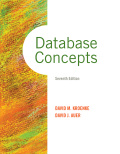
Concept explainers
SQL:
- SQL stands for “Structured Query Language”.
- The current version of SQL is “ANSI SQL – 92”.
- It contains constructs which are used to define and process
database . They are executed using DBMS-supplied command prompt. - SQL is not a
programming language. It is text-based and it is also called as data sublanguage. In order to get SQL as a complete programming language, it should be included in scripting languages like Java, C#, and so on.
Display values from table:
The contents from the table can be viewed by using “SELECT” statement which comes under Data Manipulation Language (DML). Syntax to view the contents using asterisk (*) is as follows:
SELECT * FROM table_Name;
Grouping Rows:
SQL contains “GROUP BY” clause in order to group rows by common data. Though it is very powerful feature, it is hard to understand.
Syntax:
SELECT column_Name1 FROM table_Name GROUP BY column_Name2;
Example: Consider a table “student” contains two columns “student_Name” and “Department”. “GROUP BY” clause is used when there is a need to get the number of students from each department.
The query for this scenario is given as follows.
SELECT department, COUNT (department) FROM student GROUP BY department;
When the above query is executed, number of students from each department will be displayed.
Want to see the full answer?
Check out a sample textbook solution
Chapter 3 Solutions
EBK DATABASE CONCEPTS
- I need help in explaining how I can demonstrate how the Laplace & Inverse transformations behaves in MATLAB transformation (ex: LIke in graph or something else)arrow_forwardYou have made the Web solution with Node.js. please let me know what problems and benefits I would experience while making the Web solution here, as compared to any other Web solution you have developed in the past. what problems and benefits/things to keep in mind as someone just learningarrow_forwardPHP is the server-side scripting language. MySQL is used with PHP to store all the data. EXPLAIN in details how to install and run the PHP/MySQL on your computer. List the issues and challenges I may encounter while making this set-up? why I asked: I currently have issues logging into http://localhost/phpmyadmin/ and I tried using the command prompt in administrator to reset the password but I got the error LOCALHOST PORT not found.arrow_forward
 Database Systems: Design, Implementation, & Manag...Computer ScienceISBN:9781285196145Author:Steven, Steven Morris, Carlos Coronel, Carlos, Coronel, Carlos; Morris, Carlos Coronel and Steven Morris, Carlos Coronel; Steven Morris, Steven Morris; Carlos CoronelPublisher:Cengage Learning
Database Systems: Design, Implementation, & Manag...Computer ScienceISBN:9781285196145Author:Steven, Steven Morris, Carlos Coronel, Carlos, Coronel, Carlos; Morris, Carlos Coronel and Steven Morris, Carlos Coronel; Steven Morris, Steven Morris; Carlos CoronelPublisher:Cengage Learning A Guide to SQLComputer ScienceISBN:9781111527273Author:Philip J. PrattPublisher:Course Technology Ptr
A Guide to SQLComputer ScienceISBN:9781111527273Author:Philip J. PrattPublisher:Course Technology Ptr Database Systems: Design, Implementation, & Manag...Computer ScienceISBN:9781305627482Author:Carlos Coronel, Steven MorrisPublisher:Cengage Learning
Database Systems: Design, Implementation, & Manag...Computer ScienceISBN:9781305627482Author:Carlos Coronel, Steven MorrisPublisher:Cengage Learning Programming with Microsoft Visual Basic 2017Computer ScienceISBN:9781337102124Author:Diane ZakPublisher:Cengage Learning
Programming with Microsoft Visual Basic 2017Computer ScienceISBN:9781337102124Author:Diane ZakPublisher:Cengage Learning Np Ms Office 365/Excel 2016 I NtermedComputer ScienceISBN:9781337508841Author:CareyPublisher:Cengage
Np Ms Office 365/Excel 2016 I NtermedComputer ScienceISBN:9781337508841Author:CareyPublisher:Cengage





